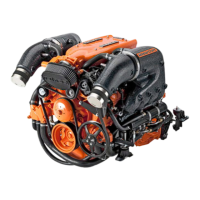© 5/2013 Ilmor Marine, LLC, Version 1.0 4-7
BEFORE EACH USE
CHECK THE SEA STRAINER – POST-
ENGINE START-UP
1. Start the engine.
2. Open the engine compartment and locate the sea strainer.
3. Aer 20 seconds of run time, check the sea strainer to make sure it is
full of water with minimal air bubbles. If you have too much air in the
strainer, check to make sure the cap/lid is securely closed and sealed.
Check for leaks leading up to the oil/transmission cooler.
4. Close the engine compartment.
NOTICE: Air in the system could cause the raw water impeller to fail,
causing severe engine problems. If air in the system is persistent, visit
your local Ilmor service center.
CHECK THAT THE BATTERY IS FULLY
CHARGED
As the boat is started, check all gauges but pay particular attention to the
voltmeter.
With the key on, but before starting the engine, the voltmeter should read
above 12 volts. Aer starting the engine, check to see that the voltmeter
reads between 12.8 and 14 volts. An erratic reading can be a sign of low
voltage. e voltmeter is the best indication of the state of the battery.
However, it is not foolproof. While the reading will indicate that the battery
is producing current, if in a previous outing there was reason to suspect a
problem with the battery(ies), check with a certied Ilmor dealer.
If the charge has fallen too low or if the battery is older or fails to hold
a charge at the expected level, the boat may not start. For additional
questions about your battery(ies), contact your boat manufacturer’s
authorized dealer.
WARNING! Always keep all sparks, ames and smoking materials away
from the battery charging area. In the event of a dead battery, charge it
with a battery charger before attempting to start the engine. Jump-starting
from another boat or battery is dangerous. Charging a dead battery with
the alternator on the boat will put undue stress on the alternator, and that,
in turn, may cause it to fail.
INCOMING
RAW WATER
OPEN
CLOSED
SEACOCK
STRAINER
TYPICAL SEACOCK AND STRAINER

